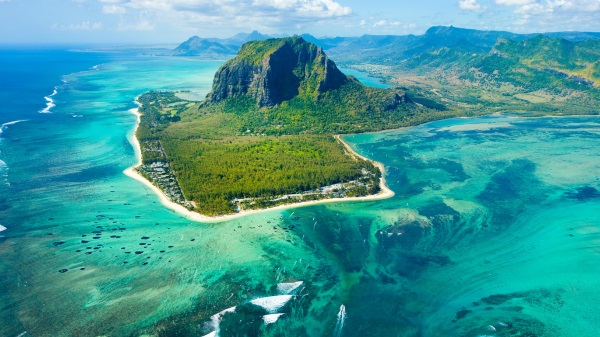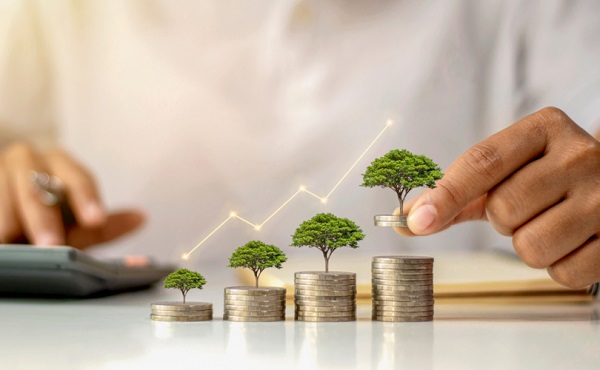Environment
Rising Seas Not Resulting in Disappearing Islands

From Heartland Daily News
A spate of recent articles acknowledges a fact that Climate Realism has long discussed. Most island nations, rather than sinking beneath the waves as seas rise amid modest warming, as predicted by climate alarmists and island profiteers, are, in fact growing.
Writing for The Pipeline, Buck Throckmorton thoroughly debunks claims that recent collapses of houses built on the shores of barrier islands in North Carolina were caused by climate change:
[B]arrier islands … are impermanent deposits of sand, which reshape, move, merge, appear, and disappear due to tides, winds, and storms.
The movement of barrier islands is not due to rising sea levels, it is due to a naturally occurring force called “longshore drift.” Where there are man-made efforts to stabilize barrier islands with jetties and sea walls, this produces other impacts on currents that cause erosion in some waterfront areas and new sand deposits in others. Beach houses in the Outer Banks are not being lost due to rising sea levels, they are being lost due to shifting sands.
Throckmorton also pointed to the disappearance of Tucker’s Island, off the coast of New Jersey, which completely disappeared due to “long-shore drift,” not rising seas.
NOAA describes the impact of long-shore drift, thusly:
Longshore drift may also create or destroy entire barrier islands along a shoreline. A barrier island is a long offshore deposit of sand situated parallel to the coast. As longshore drifts deposit, remove, and redeposit sand, barrier islands constantly change.
Semi-permanent, shifting barrier islands are not the only types of islands not being destroyed by climate change-induced rising seas. Even The New York Times (NYT) was recently forced by reality to admit that coral atolls, long the poster child of rising seas claiming nations, have been expanding and adding land amidst the Earth’s slight recent warming.
As recently as April 2024, with a story titled “Why Time Is Running Out Across the Maldives’ Lovely Little Islands,“ the NYT was still pushing the lie that rising seas threaten dozens of island nations, consisting of hundreds of small coral atolls, with extinction. Reality forced the NYT to reverse itself in the space of just three months. The author of a late June article, “A Surprising Climate Find,” wrote:
Of late, though, scientists have begun telling a surprising new story about these islands. By comparing mid-20th century aerial photos with recent satellite images, they’ve been able to see how the islands have evolved over time. What they found is startling: Even though sea levels have risen, many islands haven’t shrunk. Most, in fact, have been stable. Some have even grown.
The problem with this narrative is that the fact of growing islands during the recent period of climate change is not new news. In fact, as my colleague Linnea Lueken noted in a recent piece, the study the NYT references was published in 2018, six years ago. It found 89 percent of islands in the Pacific and Indian Oceans increased in area or were stable, and only 11 percent showed any sign of contracting.
Indeed, geological understanding of coral atoll growth and demise is not newly discovered.
“Scientists have known for decades, if not more than a hundred years, that atoll islands uniquely change with changing sea levels,” Lueken points out. “Charles Darwin was the first to propose that reefs were many thousands of feet thick, and grow upwards towards the light. He was partially correct, though reality is more complicated than his theory.”
Repeated studies show that what is true of the Maldives, growth amid rising seas, is equally true of the islands that make up Tuvalu and Kiribati, and across the island chains of Micronesia. One well-cited study from 2015 reported that 40 percent of islands in the Pacific and Indian Oceans were stable, and another 40 percent had grown, in recent decades.
Oceans, oceans everywhere, and nowhere can be found the much-bemoaned decline in island nations hyped be climate hucksters with regularity. When even the NYT is forced to admit this truth, you know the climate alarm narrative is in trouble.
Sources: The Pipeline; The New York Times; Climate Realism
Business
WEF has a plan to overhaul the global financial system by monetizing nature

From LifeSiteNews
By Tim Hinchliffe of The Sociable
The WEF is plowing full steam ahead with the globalist agenda to monitor and monetize everything in nature, including the air we breathe, the water we drink, and the very earth we walk upon.
With billionaires Larry Fink and Andre Hoffmann as the new co-chairs, the World Economic Forum (WEF) publishes a 50-page blueprint on how to monetize everything in nature.
The WEF’s latest insight report, “Finance Solutions for Nature: Pathways to Returns and Outcomes,” provides “stakeholders” with dozens of financial solutions for monetizing everything in nature.
Nature pricing, biodiversity crediting schemes, natural asset companies, debt-for-nature swaps, and so much more are all packed into this agenda to overhaul the global financial system with nature-based activities:
The landscape of nature finance is rapidly evolving. From sovereign debt instruments and blended capital platforms to biodiversity credits and emerging asset classes, a growing range of mechanisms is being deployed to fund, finance and de-risk nature-positive action.

The WEF leadership page says that in their work on the board of trustees, “members do not represent any personal or professional interests.”
However, the target audiences for latest WEF insight report are “institutional investors, banks, asset managers, and development actors” – the very business interests that Hoffmann and Fink represent.
WEF interim co-chairs Larry Fink and Andre Hoffmann have everything to gain in their business dealings should the documentation, monetization, and tokenization of everything in nature ever come to full fruition.
And they are well on their way.
Fink’s BlackRock manages over $11 trillion in assets, and last year BlackRock said it was “conducting proprietary research on natural capital investment signals, identifying companies poised for financial advantage in avoiding nature-related risks or leaning into opportunities. Those signals cover themes such as energy management, water management, waste management and biodiversity – and can feed into portfolio construction or support custom exposures.”
Hoffmann is also a key player in a whole host of so-called green financing initiatives, including biodiversity crediting schemes, through his various roles as founder, president, and chairman at several companies and NGOs such as: Innovate 4 Nature – the “accelerator for nature-positive solutions” and Systemiq – the “system change company” established specifically to advance U.N. Agenda 2030.
“The economy depends on natural resources. Their value derives not only from their use as direct inputs to production – such as timber for construction – but also for their benefits to society like living trees that help clean the air. Economists use the term “natural capital” to refer to the total value that natural resources provide to the economy and to people.” — BlackRock, Capital at risk: nature through an investment lens, August 2024
Investigative journalist Whitney Webb: BlackRock and other companies are attempting to seize control over the natural world under the guise of "saving the planet".
"BlackRock being able to unlock and take control of as many natural assets as possible… is obviously a way for… pic.twitter.com/XgRBBqW7qr
— Wide Awake Media (@wideawake_media) February 26, 2025
“Debt-for-nature swaps [DNS] are a financial mechanism that allow countries to restructure bilateral or multilateral debt in exchange for commitments to fund local conservation and restoration. They are also known as ‘debt-for-nature conversion.’” — WEF, Finance Solutions for Nature: Pathways to Returns and Outcomes, September 2025

Is your country millions, billions, or trillions in debt? No problem!
With debt-for-nature swaps, you can restructure your nation’s debt just by letting somebody else come in and take control of your natural resources under the guise of conservation and restoration, but what they’ll really be doing is forcing you to “take out private insurance policies to ‘mitigate the financial impact of natural disasters‘ as well as ‘political risk,’” as investigative journalists Whitney Webb and Mark Goodwin report in Bitcoin Magazine.
Don’t have any money, but want to create value out of thin air, water, soil, or trees? You can set up natural asset companies that can “convert the full economic value of nature into financial flows via equity models.”

Want to help asset managers, bankers, and hedge fund execs get extremely rich while leaving you with only a tiny fraction? Go ahead and get involved in a Payment for Environmental Services (PES) scheme, where financial incentives are provided to individuals or communities in exchange for maintaining or restoring ecosystem services, like carbon sequestration or biodiversity conservation
And if you’re compliant with their rules, you can be rewarded by producing “positive nature and biodiversity outcomes (e.g. species, ecosystems and natural habitats) through the creation and sale of either land or ocean-based biodiversity units over a fixed period” with biodiversity credits, aka “environmental credits.”
Prefer to be left alone and live on the property that you worked hard for all your life? You better be compliant with all the environmental regulations that are coming in the name of preserving biodiversity, so that the $44 trillion of economic value generated by nature doesn’t diminish.
With Larry Fink & Andre Hoffmann having everything to gain, today the WEF published a blueprint for the complete monetization of everything in nature. Natural Asset Companies, Biodiversity Credits, Debt for Nature Swaps, Payments for Ecosystem Services https://t.co/bV1SBKlM41 pic.twitter.com/knqErANBlV
— Tim Hinchliffe (@TimHinchliffe) September 11, 2025
“Environmental credits are verified units of positive environmental outcomes, including biodiversity, water, carbon and nutrient credits. Though developed independently, projects increasingly blend credits via stacking, bundling or stapling.” — WEF, Finance Solutions for Nature: Pathways to Returns and Outcomes, September 2025

“Nature is rapidly emerging as a strategic investment frontier and more institutional capital is flowing into new business models and projects.” — WEF, Finance Solutions for Nature: Pathways to Returns and Outcomes, September 2025
In keeping with the own self-interests of the co-chairs and their business relations, the report highlights “10 priority financial solutions” for these stakeholders to implement:
- Sustainability-linked bonds (SLBs):
- Commercial bonds tying coupon rates to nature-related targets for corporates or governments.
- Thematic (or use-of-proceeds) bonds:
- Bonds with proceeds earmarked for nature projects. Scaling-up requires clearer guidance and aggregation to improve outcomes for issuers and investors.
- Sustainability-linked loans (SLLs):
- Flexible debt, linking interest rates to nature-related targets. SLLs need simpler verification, standardized metrics and stronger triggers to drive nature-positive lending.
- Thematic (or use-of-proceeds) loans:
- Loans for specific nature-related projects. Greater clarity on taxonomies and aggregation is needed to enhance capital flows.
- Impact funds:
- Funds investing in nature-positive outcomes, often accepting higher risk or longer pathways to returns.
- Natural asset companies (NACs):
- Publicly and privately listed companies that convert the full economic value of nature into financial flows via equity models. NACs hold significant potential but need more transactions for price discovery and replicable investment blueprints.
- Environmental credits:
- Tradeable certificates for verified environmental benefits, used in compliance or voluntary markets.
- Debt-for-nature swaps (DNS):
- Mechanisms to restructure sovereign debt in exchange for conservation or restoration commitments, with investable components including bonds and loans.
- Payments for ecosystem services (PES):
- Contracts rewarding conservation for specific ecosystem services, driven by the public sector. Private sector schemes require longer contracts, aggregation and supply chain integration to scale up.
- Internal nature pricing (INP):
- Unexplored, voluntary shadow pricing or fee-based tools to incentivize nature-positive performance in companies or across investment portfolios, similar to internal carbon pricing (ICP).
“While some components of nature – such as food, timber and ecotourism are priced and traded in global markets, the value of many critical ecosystem services remains undervalued….
Carbon sequestration, water filtration, flood protection and pollination are often treated as ‘free’ inputs, despite underpinning our economies and societies.” — WEF, Finance Solutions for Nature: Pathways to Returns and Outcomes, September 2025

“The natural capital approach extends the economic concept of capital to the environment, conceptualizing stocks of natural resources as conventional goods worth restoring, maintaining and enhancing for their productive flows.
This approach includes both accounting – embedding nature in national and corporate balance sheets – and valuation – pricing nature’s contributions into cost-benefit and investment analysis.” — WEF, Finance Solutions for Nature: Pathways to Returns and Outcomes, September 2025
Putting prices on water, air, and soil is a hot topic among globalists at the U.N., the G20, the World Economic Forum (WEF), and the COP meetings.
At the WEF Annual Meeting in Davos this year, Singapore’s President Tharman Shanmugaratnam said that water credits and biodiversity credits should be “stapled” on to carbon credits.
Singapore President Tharman Shanmugaratnam tells the WEF he wants to put a price on everything in nature: "Just like we've got carbon credits, WE NEED TO DEVELOP THE MARKET FOR WATER CREDITS & BIODIVERSITY CREDITS" #wef25 https://t.co/wv04rzht3K pic.twitter.com/UuSiDBSuu3
— Tim Hinchliffe (@TimHinchliffe) January 21, 2025
"Much better that we work on a reliable CARBON CREDIT system with the stapling on of WATER & BIODIVERSITY CREDITS": Singapore President Tharman Shanmugaratnam at the WEF #wef25 https://t.co/wv04rzht3K pic.twitter.com/EhWCvZAsxj
— Tim Hinchliffe (@TimHinchliffe) January 21, 2025
The year prior, at the 2024 WEF Annual Meeting of the New Champions, aka “Summer Davos” meeting in communist China, University of Cambridge Institute for Sustainability Leadership CEO Lindsay Hooper told the panel on “Understanding Nature’s Ledger” that every part of the economy depends on nature, and that in order to protect natural systems, one solution would be to “bring nature onto the balance sheet.”
"We can't do business on a dead planet. If we're going to protect natural systems, one of the solutions is to bring nature onto the balance sheet; bring nature into the ways that decisions are made within business to allocate a value to it" Lindsay Hooper WEF #AMNC Summer Davos pic.twitter.com/Y1dpjMgmS6
— Tim Hinchliffe (@TimHinchliffe) June 27, 2024
In addition to putting “nature on the balance sheet,” another proposal coming at the end of the panel discussion suggested putting a tax on natural systems like water in the same vein as carbon taxes.
"Beyond carbon [taxes] let's think about other aspects of nature that are easier to quantify.. What about water? That's quite possible for us to start integrating systematically into current trading carbon pricing mechanisms" WEF managing director Gim Neo #AMNC24 Summer Davos pic.twitter.com/0rlomVk3ph
— Tim Hinchliffe (@TimHinchliffe) June 27, 2024
With putting prices on nature comes tokenization and derivatives.
At least that’s what former Bank of England adviser Michael Sheren said at COP27 in November 2022.
'Carbon is moving very quickly into a system where it's going to be very close to a currency' …
Next, 'We start thinking about putting prices on water, on trees, on biodiversity … How do we start tokenizing?': Michael Sheren, Former Bank of England Advisor #COP27 pic.twitter.com/r5Nw3b2aeo— Tim Hinchliffe (@TimHinchliffe) November 9, 2022
“Carbon, we already figured out, and carbon is moving very quickly into a system where it’s going to be very close to a currency, basically being able to take a ton of absorbed or sequestered carbon and being able to create a forward-pricing curve, with financial service architecture, documentation,” said Sheren.
And with carbon being close to a currency, “There are going to be derivatives.”
"The biggest challenge is how do we move from a SHAREHOLDER ECONOMY to a STAKEHOLDER ECONOMY" Andre Hoffmann WEF interim co-chair. Agenda 2030 advocate, Club of Rome member, Chatham House Adviser, heir to the 5th largest pharma company in the world, Roche https://t.co/NQlEF36IRy pic.twitter.com/kPI2jtDNxL
— Tim Hinchliffe (@TimHinchliffe) August 20, 2025
Now, under the newfound leadership of Fink and Hoffmann, whose personal business dealings stand everything to gain, the WEF is plowing full steam ahead with the globalist agenda to monitor and monetize everything in nature, including the air we breathe, the water we drink, and the very earth that we walk upon.
Reprinted with permission from The Sociable.
Alberta
How Alberta is moving to speed up oil sands reclamation with mine water treatment

From the Canadian Energy Centre
New standards to build on rules already in place for other mining sectors
In what the former Chief of the Fort McKay First Nation calls “a critical step in the right direction,” the Alberta government is moving to accelerate reclamation of more than 1.3 trillion litres of water stored in oil sands tailings ponds.
On Sept. 5, the province announced it will expedite setting standards that allow for “mine water” to be treated and released into the environment, building on the rules that are already in place for other mining operations across Canada.
“We cannot ignore this challenge, we need to keep working together to find practical and effective solutions that protect Indigenous rights, people and the environment,” said Chief Jim Boucher, a member of Alberta’s Oil Sands Mine Water Steering Committee.
That committee is behind a suite of nine recommendations that Alberta is putting into action to improve mine water management and tailings pond reclamation.
The Mining Association of Canada (MAC) says decades of research give the industry confidence that mine water can be safely treated and released once regulations are in place.
But that will take the federal government moving faster too.
Both the federal and provincial governments play a role in potential regulations for the treatment and release of oil sands mine water.
“Alberta is proposing science-based parameters to ensure the safe return of treated water used in oil sands mining, just as other provincial governments do for their respective mining sectors,” MAC CEO Pierre Gratton said in a statement.
“We are hopeful that this will accelerate the development of federal regulations – which we requested almost 15 years ago – to be similarly advanced.”
Gratton said setting standards for safe mine water release could unlock “significant investments” in oil sands reclamation and water treatment.
What are tailings ponds?
Tailings are a byproduct of mining operations around the world.
Oil sands tailings ponds are engineered basins holding a mix of mine water, sand, silt, clay and residual bitumen generated during the extraction process. There are eight operating oil sands mines with tailings ponds in northern Alberta.
Recycling water held in these basins helps operators reduce the amount of fresh water withdrawn from the Athabasca River.
In 2023, 79 per cent of the water used for oil sands mining was recycled, according to the Alberta Energy Regulator.
What is oil sands mine water?
Oil sands mine water is water that comes into contact with the various stages of oil sands mining operations, including bitumen extraction and processing.
Tailings ponds in the oil sands also hold water from significant amounts of rain and snow collected in the decades since the first mines began operating.
While the oil sands mining sector has reduced the amount of fresh water it uses per barrel of oil produced by nearly one-third since 2013, the total volume of mine water in tailings storage has grown as production has increased.
What’s in oil sands mine water?
The constituents of oil sands mine water requiring treatment for safe release are both typical of water in other industrial processes and unique to the oil sands sector.
MAC says common materials are suspended solids like sand, silt and clay, as well as a range of metals. These can be treated by a wide range of proven technologies already in use in Canada and globally.
Unique to oil sands mine water are organic compounds such as naphthenic acids. According to MAC, operators have demonstrated and continue to invest in processes to treat these to levels safe for environmental release.
How does mine water impact reclamation?
At the end of an oil sands mine’s life, operators must remove all infrastructure and restore the land to features of a self-sustaining boreal forest similar to what was there before.
Addressing the challenge of tailings ponds and the mine water stored in them is critical to the overall success of oil sands mining reclamation.
Why is mine water release important?
MAC says the only way to remove mine water in tailings ponds is to treat it for safe release to the environment.
Strict regulations allow for this process across Canadian copper, nickel, gold, iron ore, and diamond mining operations. But it is prohibited in the oil sands.
The safe release of treated oil sands mine water into the environment can reduce the need to store it, minimize further land disturbance and help reclamation happen faster.
MAC says operators have shown they can treat mine water to safe release levels, using processes that include innovative technologies developed through Canada’s Oil Sands Innovation Alliance.
What is Alberta doing?
Alberta has accepted the Oil Sands Mine Water Steering Committee’s nine recommendations aimed at speeding up solutions for safe mine water release.
The province says the recommendations, developed with input from industry, technology providers, Indigenous communities and scientists, will now be evaluated to determine how they can be put into practice.
-

 COVID-192 days ago
COVID-192 days agoDevastating COVID-19 Vaccine Side Effect Confirmed by New Data: Study
-

 Red Deer2 days ago
Red Deer2 days agoThe City of Red Deer’s Financial Troubles: Here Are The Candidates I Am Voting For And Why.
-

 Business2 days ago
Business2 days agoCanada Post is failing Canadians—time to privatize it
-

 Business2 days ago
Business2 days agoYour $350 Grocery Question: Gouging or Economics?
-

 2025 Federal Election11 hours ago
2025 Federal Election11 hours agoProtestor Behind ‘Longest Ballot’ Chaos targeting Poilievre pontificates to Commons Committee
-

 Media2 days ago
Media2 days agoResponse to any budget sleight of hand will determine which audience media have decided to serve
-

 Education2 days ago
Education2 days agoClassroom Size Isn’t The Real Issue
-

 illegal immigration2 days ago
illegal immigration2 days ago$4.5B awarded in new contracts to build Smart Wall along southwest border





